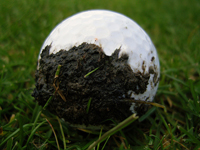More often than not during any given tournament, a player who has lifted his ball will ask a rules official if he can clean it–and you might be surprised how many times the answer is “Yes.” Rule 21 (Cleaning Ball) is the shortest Rule in the book because it outlines three times a player may NOT clean his golf ball. It should be noted that, as an exception to this Rule, a ball on the putting green may be lifted and cleaned without penalty. Historically speaking, this Rule has become much more liberal over the past 60 years. It was not until 1946 that the USGA put the first reference to cleaning the golf ball in the book–prior to that the ball could not be cleaned at any time during the play of the hole. The last revision to Rule 21 occurred in 1980 at which point the penalty for cleaning the golf ball when not permitted was changed from a loss of hole penalty in match play and two-stroke penalty in stroke play to a one-stroke penalty in both forms of play.
The three instances under when the ball cannot be cleaned (Rule 21) are: (a) if it has been lifted to determine if it is unfit for play (Rule 5-3), (b) if it has been lifted to be identified (Rule 12-2), and (c) it has been lifted because it was assisting or interfering with play (Rule 22). However, if a player has lifted his ball for identification (“˜b’ above), he may clean it only to the extent necessary to identify it. For example, the player can clean off where he believes the identification mark (i.e., black dot next to “Titleist”) but no more.
Two additional instances to when a ball lifted may not be cleaned have since been added to the Decisions on the Rules of Golf bringing the total to five. These situations invlove when a ball is lifted to determine if it is in a burrowing animal hole or if it has been lifted to determine whether or not it is embedded. If it is determined to be in either of these two conditions the player may proceed under Rule 25 (Abnormal Ground Conditions) which permits the player to clean the ball. However, if it is determined that the ball is not in either condition, the ball must be replaced on the exact spot from which it was lifted without cleaning it. This procedure applies to all five instances in which a lifted ball cannot be cleaned.
Knowing these five situations makes it easy to know when you CAN clean your ball when it has been lifted. Here are a couple of examples of when a player may clean the golf ball.
1) Pete addresses his ball in the fairway and the ball moves. The player is required to replace the ball with a penalty of one-stroke, but he may clean the ball before replacing it.
2) Aaron’s ball lies in a bunker, Eric makes a stroke at his ball and deflects Aaron’s ball in the bunker. In this case, Eric should play his ball as it lies, but Aaron is required to replace his ball on the spot from which it was deflected without penalty and before doing so he may clean the ball.
So keep your towel wet, because you can use it more often that you think out there!


